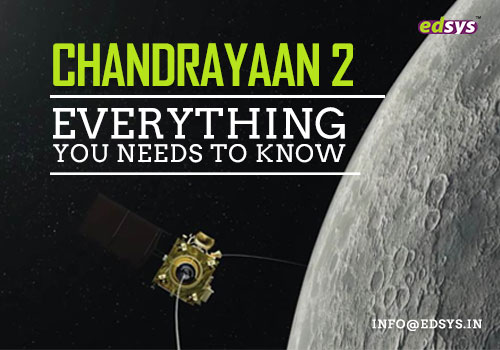Categories(658 Blogs)
Select Category
Watch Right Now
Teacher App - Class
Schedule & Attendance Management App
Parent App from Edsys

Best School Bus Tracking System

Cashless School - For Smart Schools of Tomorrow


Chandrayaan 2 : Everything You Need To Know

Chandrayaan 2 – India’s most awaited second mission to moon set out its way to Moon on 14 July 2019 at 2.51pm. People around the globe had been staying curious about this follow-up mission and its launch since Chandrayaan 1 – the first successful moon mission attempt by ISRO (India Space Research Organisation).
Chandrayaan 2 was rescheduled several times due to different technical reasons. However, breaking all barriers, it has embarked on its journey with the key objective of mapping lunar water.
Here are a few interesting facts about India’s second Moon Mission
Let’s Have a Look into the Details,
- Chandrayaan 2 is the successor to chandrayaan 1 launched on Oct 22, 2008
- Chandrayaan 2 is the second space mission of India to the moon.
- Chandrayaan2 is the first mission ever to the moon’s North Pole.
- Rocket used – Geosynchronous Satellite Launch Vehicle Mark III-M1.
- Chandrayaan 2 was launched from- Satish Dhawan Space Center, Sriharikota, Andhra Pradesh.
- Chandrayaan 2 weighs 3.5 tons and consists of three modules/vehicles.
- This mission is expected to make India the fourth country which soft-land a craft on the moon surface after Russia, America, and China.
What are the Three Modules in Chandrayaan 2?
1) Orbiter
The orbiter weighs 2379 kg and consists of
Terrain Mapping Camera – for three-dimensional mapping of the lunar surface.
Spectrometers – measure spectral components and observes water molecules.
Synthetic Aperture Radar – used to create two-dimensional images or three-dimensional reconstructions of objects
Radio Occultation – a remote sensing technique used for measuring the physical properties of a planetary atmosphere.
Solar X-Ray Monitor– Observes emission of solar X-ray. It is built and fed to perform the observations one earth year on the orbit.
2) Lander
Chandrayaan 2 lander is also called as ‘Vikram’ in commemoration of Vikram Sarabhai. It weighs 1471 kg and it includes the rover as well. Lander can correspond to the Indian deep space network, the Orbitor, and the Rover.
It consists of highly advanced instruments for collecting accurate data such as;
Camera – to map out the terrains and landing site of Lander and Rover.
Seismometer -an instrument that responds to ground motions, eg- earthquakes, volcanic eruptions, and explosions.
Thermal profiler – recording and interpreting the temperatures of products and/or air through a conveyorized heat-treating process .
Langmuir probe – a device used to determine the electron temperature, electron density, and electric potential of a plasma.
Laser retroreflector – Device or surface that reflects radiation (light) back to its source with a minimum of scattering.
3) Rover
ISRO loves to call chandrayaan 2 Rover as Prayag- which means- wisdom in Sanskrit.
The rover is a 6-wheel- a solar-powered vehicle which can travel up to 500m at a speed of 1 cm/sec. It is expected to last one lunar day.
It will deploy within moments after the soft-landing. It can communicate with the Lander directly.
This vehicle is equipped with advanced Laser-Induced Breakdown Spectroscope to carry out lunar observations, Alpha-proton X-ray spectrometers, and subsequent instruments.
What are the Major Objectives of Chandrayaan 2?
- To prove the capability to soft-land on the lunar surface and deploy the rover.
- To figure out the mineral components and hydroxyl and water ice molecules.
- Study about lunar topography and elemental diversity over the lunar surface.
- Learn the density of electrons in the ionosphere of the moon surface.
- Exclusive mapping of the lunar surface to figure out the chemical composition which can ‘ Shed light to mysteries of origin.
How Chandrayaan 2 differ from Chandrayaan 1?
Chandrayaan 1
- India’s first mission to explore the moon.
- The rocket used- Polar Satellite Launch Vehicle, PSLV-C11
- Chandrayaan 1 weights 1380 kg and made more than 3400 orbits.
- Discovered traces of water ice on the north pole region of the moon.
- Find out the presence of magnesium, Aluminium, and Silicon on the lunar surface.
- Instruments used are outnumbered Indian equipment.
2. Chandrayaan 2
- India’s second mission for detailed moon expedition.
- Rocket used – Geosynchronous Satellite Launch Vehicle Mark III-M1
- Chandrayaan 2 comprises of three modules and weighs 3850 kg.
- Most of the instruments used are home-made except for LSR.
- Expected mission life is 365 day and for Lander and Rover is once a lunar day.
Final Words
Children, hope you got a quick and decent understanding of Chandrayaan 2.
Space science is an endless subject, each finding inspires another and every discovery is exciting.
Delve deep into it you can find precious pearls that can redefine the universe.
Recent Blogs
Our Educational Services
Popular Blogs
Subscribe

SUBSCRIBE TO OUR NEWSLETTER
Sign Up and Recieve the Latest News
Don’t Worry, We Don’t SpamExplore Our Extensive Researched Educational App Directory
Visit Now















